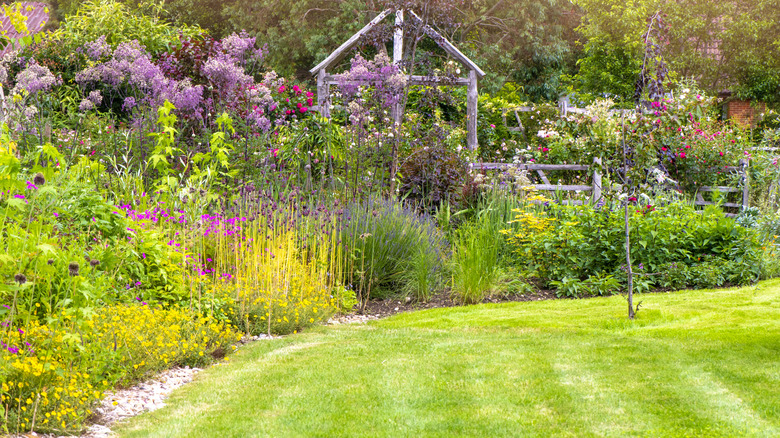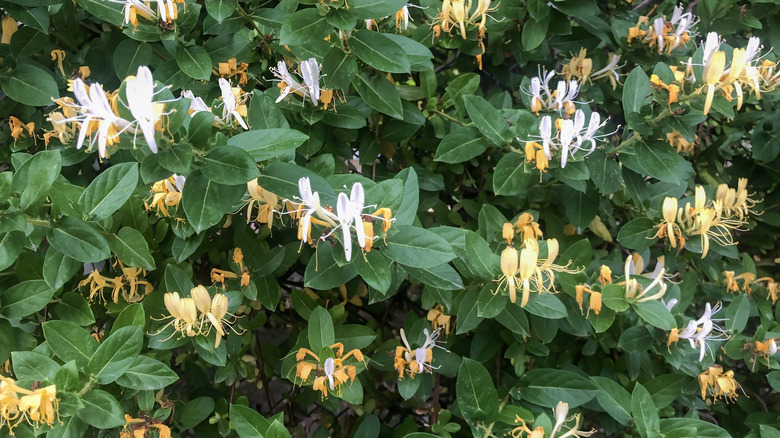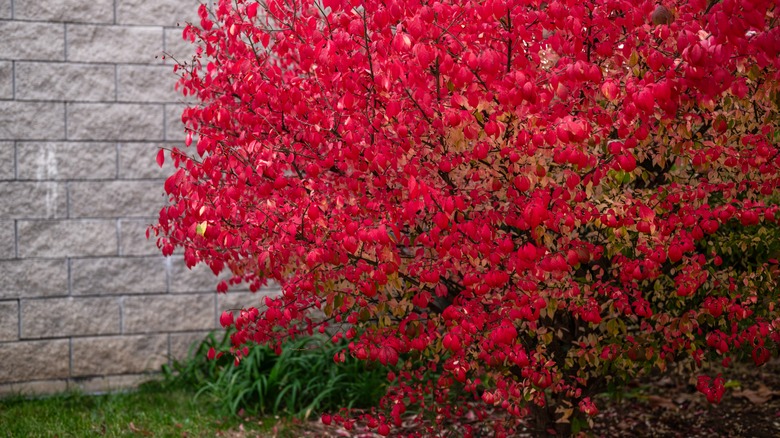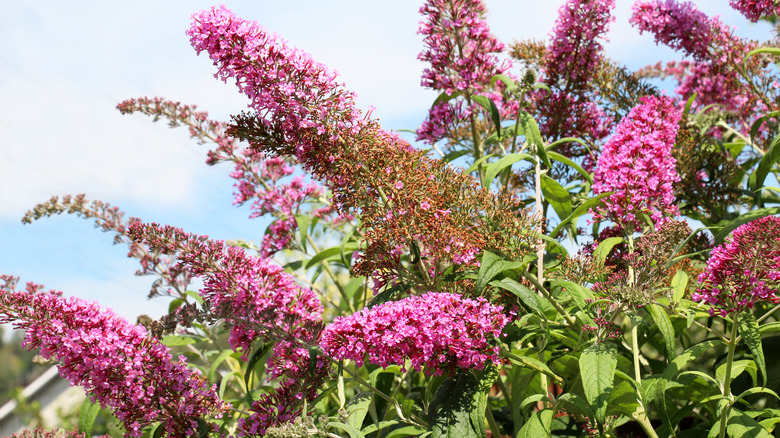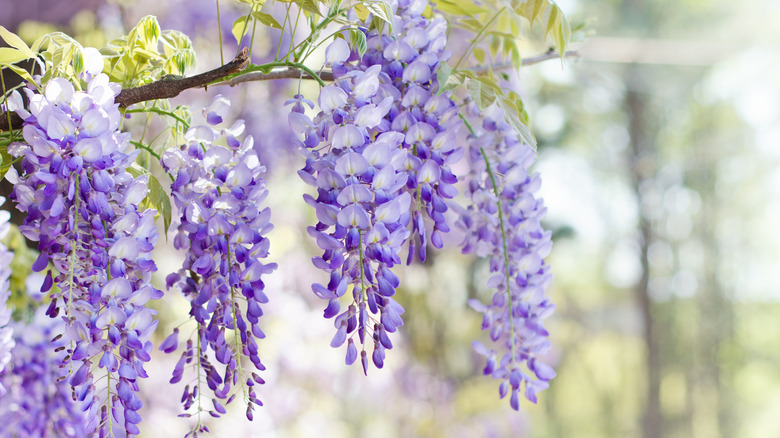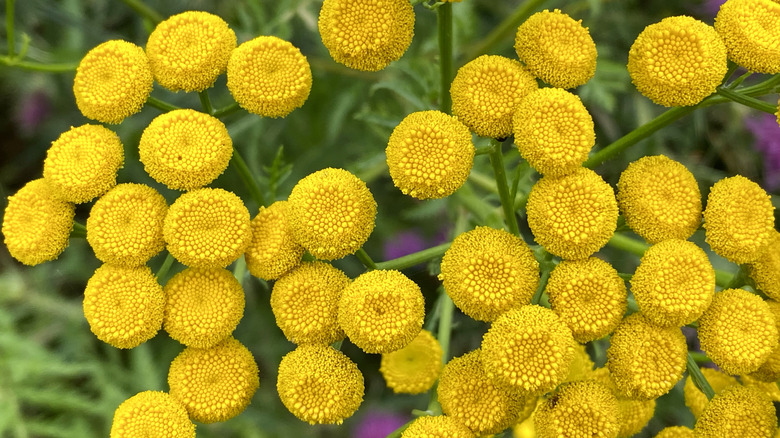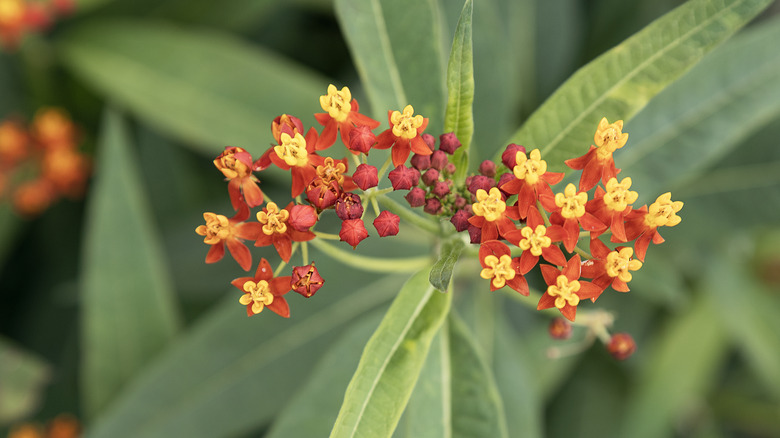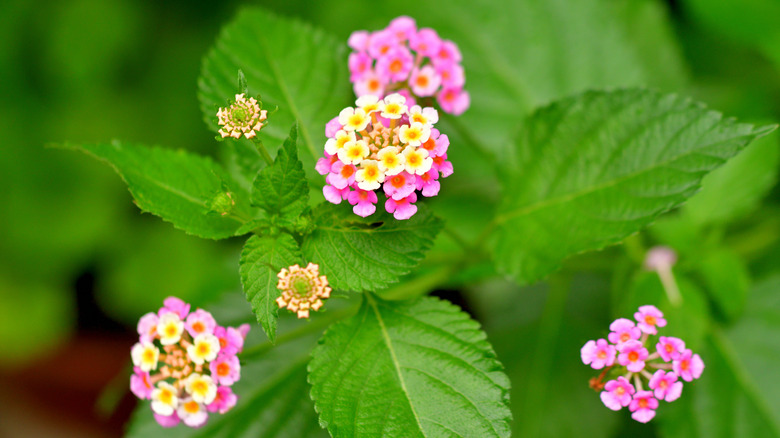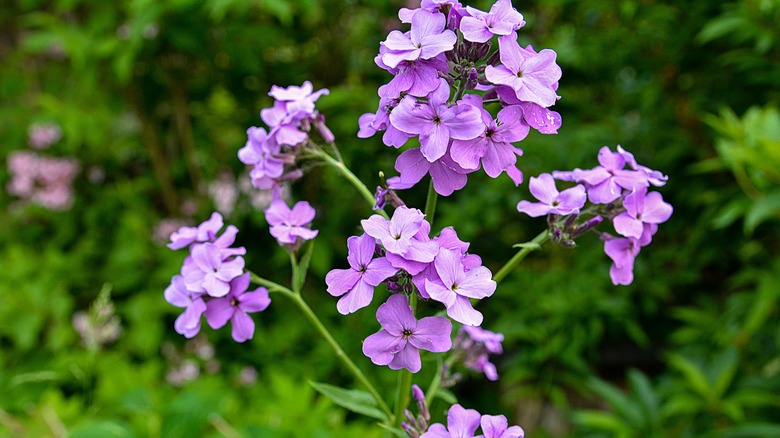These Beautiful Flowering Plants Will Wreak Havoc On Your Yard And Garden
As you look at beautiful flowering plants buzzing with pollinators, it can be hard to imagine that some of them could be causing more harm than good to the ecosystem. Fast spreaders can choke out neighboring plants in your garden or make it difficult for them to get the nutrients they need. Additionally, many non-natives can quickly escape cultivation, causing them to outcompete and displace native ecosystems. Because of the aggressive spreading nature of many of the below plants, they can be hard to control if you don't act quickly.
If you spot an invasive species in your garden, you'll want to stop it in its tracks before it becomes problematic. The best way to tackle the plant depends on the species. Manual removal will be most effective for some varieties, while others may require a strong herbicide treatment. Alternatively, some of these non-native invasive plants sit in the aisles of gardening centers or nurseries, so it's important to avoid them and choose a native instead. Thankfully, there is a better alternative to nearly all the plants on this list, so you can choose a species that benefits your yard or garden rather than putting it at risk.
Japanese honeysuckle
Honeysuckle plants (Lonicera spp.) are typically regarded as nectar-rich flowers that attract hummingbirds and other pollinators. However, not all species are created equal. Japanese honeysuckle (Lonicera japonica) may look like another pretty yellow flowering plant, but it's a non-native, aggressively growing woody vine that can smother native plants with its dense mats that block sunlight. Pair that with its rapid growth and ability to root at multiple nodes along the vine, and you have a recipe for disaster. If you spot this invasive species growing in your garden, apply an herbicide in the fall when Japanese honeysuckle is dormant but before temperatures drop to freezing overnight. Because of its dense mat, retreatment may be necessary to eradicate the entire plant.
If you want to add honeysuckle to your garden, thankfully, there are several native species to choose from. Yellow honeysuckle (Lonicera flava) may look similar, but it doesn't have the same destructive growth habit. Like other woody vines, it looks stunning growing up a trellis or even as a groundcover in certain areas. This wildlife magnet is hardy in zones 5 through 8 and easily grows in fertile, well-draining soils. While it tolerates partial sun, you'll get the best blooms if it receives full sun.
Burning bush
From tiny flowers in the spring to picturesque bright red leaves and berries in the fall, the ornamental value of burning bush (Euonymus alatus) comes at a cost. This non-native spreads rapidly in favorable conditions, with birds dropping the seeds in nearby native habitats. Once established, this aggressive grower forms dense thickets and outcompetes native plants for their nutrients. Some regions in the United States even consider it a noxious weed, and many others strongly recommend considering a native alternative instead. If a burning bush pops up in your yard, remove it entirely by digging out the roots. Alternatively, cut the tree as low to the ground as possible and treat it with a high concentrate glyphosate-based herbicide.
It's hard to beat the view of vibrant red autumn leaves, so consider a native alternative like red chokeberry (Aronia arbutifolia), which offers a similar beauty and more benefits. Not only do the chokeberries add a fall flair to your backyard, but several songbirds love snacking on them. Hardy in zones 4 through 9, red chokeberry is an incredibly low-maintenance plant that you don't need to worry about pruning, aside from occasional trimming of dead branches. This hardy plant is tolerant of several soil types and tolerates partial shade, but it produces the best fruit in full sun.
Butterfly bush
With its stunning flower clusters that seem to be magnets to pollinators, it may be surprising to find out that butterfly bush (Buddleja davidii) isn't the best choice for your garden. Not only is this shrub invasive, but it isn't as helpful as you may think. Despite the common name, the butterfly bush comes from parts of China and Japan — so it isn't a host plant for any North American butterflies. With each panicle containing as many as 40,000 seeds, this non-native shrub spreads rapidly and can outcompete native flowering plants, meaning less vital food for caterpillars. So, if you see a butterfly bush in your garden, cut the trunk at the base and apply a concentrated glyphosate herbicide.
Although the pretty pollinators may stop by for a drink, it's better to choose a plant that's not only nectar-rich, but also provides food for butterflies in their larval stage. If you're drawn to the large, colorful flower clusters, blue blossom (Ceanothus thyrsiflorus) may be the perfect shrub for your garden. Native to the western coast of the United States, this vibrant shrub provides nectar for bees, butterflies, and hummingbirds. Plus, it's a larval host for certain native moth and butterfly species. Blue blossoms do best when grown in an area with full sun and average well-drained soil. You can grow this low-maintenance plant in zones 7 through 11.
Japanese rose
Sometimes referred to as multiflora rose, the Japanese rose (Rosa multiflora) is an eastern Asia native that can be problematic when grown in North America. Once grown for ornamental value and erosion control, this invasive shrub has escaped cultivation with its rapid seed dispersal. Each plant can produce a whopping 500,000 seeds, so it can quickly get out of control. Manually remove smaller plants when you notice them, but watch out for the thorns. If hand-pulling doesn't work, cut it to an inch-tall stump and apply a glyphosate herbicide in late summer to early fall.
To get the same exotic look without the invasive downsides, you can't go wrong with a garden favorite, the hardy hibiscus (Hibiscus moscheutos). Its showy blooms, reaching up to 8 inches across, attract butterflies and other beneficial insects to your garden. This beautiful native is hardy in zones 5 through 9, so it's suitable for growing in most regions. While it can tolerate partial shade, give it at least six hours of direct sunlight for the best blooms. It likes slightly acidic to slightly alkaline well-drained soil and needs regular watering during the growing season.
Chinese wisteria
Chinese wisteria (Wisteria sinensis) is undoubtedly beautiful, but it poses an ecological threat in several ways. Invasive in at least 19 states, Chinese wisteria can quickly dominate your yard. Not only does it spread rapidly, but its tough, woody vines can tightly wrap around other shrubs and trees, damaging or even killing them. This aggressive grower can also grow dense thickets that make it challenging for native plants to get the oxygen and sunlight required to grow. Removing Chinese wisteria can be tricky, as a tiny root fragment can cause it to resurface. Use a pruning saw to cut it into more manageable pieces, then dispose of the stems and any suckers you see. Attempt to dig out the entire root system, but if you can't, use a disposable paintbrush to apply herbicide to the fresh cuts.
American wisteria (Wisteria frutescens) is the perfect alternative to its weedy cousin. This showy purple flowering vine produces clusters of fragrant lilac-colored blooms that butterflies can't get enough of. Although it's native to the eastern United States, you can grow this plant in hardiness zones 5 through 9. American wisteria is a full sun lover that thrives in fertile, well-drained, and slightly acidic soil.
Yellow iris
Growing along the wetlands, the yellow iris (Iris pseudacorus) is a vibrant plant that seems to add to the scenic landscape. However, this hardy flower, which is primarily native to Europe, spreads rapidly through seeds and underground rhizomes. These can float down the water and pop up in other areas. Because of its quick-spreading and fast-growing nature, it can become a problem for native plants near its spread. This plant also contains glycosides, which are toxic to curious animals who may try to eat them. Because yellow iris flowers grow near water, manual removal is recommended over herbicidal treatment. If you hand-pull, wear gloves to avoid skin irritation and dispose of the plants in trash bags.
If you want to add some color near ponds or water sources in your yard, there are several native iris plants to choose from. One alternative is zigzag iris (Iris brevicaulis), a bluish-purple flower that thrives in wet conditions. It prefers rich, humusy, well-draining soil that's slightly acidic. You can grow it in full sun to part shade in hardiness zones 4 through 8. Because of its love of moisture, it makes the perfect plant to grow in a rain garden.
Common tansy
Common tansies (Tanacetum vulgare) are somewhat well-known for their yellow button-like blooms, but what you may not realize is this non-native is incredibly invasive. This noxious weed can produce upwards of 50,000 seeds that are spread by wind or water, so it can quickly become an infestation. Stopping the spread as soon as you notice common tansies in your yard is crucial to protect native flora. When hand-pulling, you must remove every part of the plant as it can regrow from root fragments. It also spreads through underground rhizomes, making it challenging to remove. Dig the plants out when the soil is damp to make the job easier and more effective.
Eliminating tansies may make you desire an alternative flowering plant that produces the same brightly colored blooms. Golden yarrow (Eriophyllum confertiflorum) has a strikingly similar appearance but doesn't come with the weedy downsides. Bees and butterflies will appreciate the dense clusters of small, bright yellow flowers and the plant's long blooming season, which lasts from mid-spring to late summer. It'll happily grow in well-drained soil and full sun, and it's incredibly drought-tolerant once established. Hardy in zones 7 through 11, you can grow this hardy flower in many regions across North America.
Tropical milkweed
Although native milkweeds are popular plants known to help monarch butterflies, you'll want to avoid its tropical cousin. Not only can tropical milkweed (Asclepias curassavica) harm the beloved monarchs, but it's also an invasive species that can wreak havoc on your property. Although it is a larval host plant for monarch butterflies, it blooms later in the year than native milkweed. When they see the non-native milkweed, they may mistake it for a native species, causing them to breed instead of migrate ... which could ultimately kill them. Tropical milkweed is a fast grower with a high seed dispersal, so it can quickly replace native plants in your yard, garden, or neighboring wildlife areas.
Also known by several other names, including bloodflower and sunset flower, you'll want to opt for a native alternative when shopping for milkweed plants. Butterfly milkweed (Asclepias tuberosa) is a native plant that attracts butterflies like monarchs with its bright orange flowers. It can be grown in zones 3 through 9, so nearly anyone in North America can grow this low-maintenance species. Butterfly milkweed thrives in full sun and prefers average, well-drained soil, though it can tolerate poor soils.
Bradford pear
The cloud-like display of white blooms bursting throughout the Bradford pear (Pyrus calleryana) may make it an enticing choice, but its beauty comes at a price. This tree spreads through cross-pollination, producing fruits that quickly spread through birds and other animals, which leads to dense thickets that outcompete native plants. Additionally, the tree's weak branches are prone to breakage, and its stumps sprout thorny, invasive growths. As if all that isn't bad enough, despite the abundance of blooms, the tree emits a foul, fishy odor. It's recommended to pull out younger trees or to use a glyphosate treatment to remove them. Another option is to cut the tree down and apply the concentrated glyphosate to its stump. Wear protective clothing and dispose of any plant parts in a trash bag.
When removing invasive trees from your property, it's always a good idea to replace them with a native. Serviceberry (Amelanchier spp.) produces an abundance of pretty white blooms around the same time as the Bradford pear, offering four seasons of visual interest. By summer, the tree puts out purple edible serviceberries that several bird species love. In fall, the foliage is an attractive yellow or red shade before falling off in winter. Grow serviceberry in full sun to partial shade and plant it in rich, well-drained soil. Although hardy in zones 4 through 9, several native cultivars can be easily grown in other zones.
Largeleaf lantana
Largeleaf lantana (Lantana camara) produces stunning clusters of red, orange, or yellow flowers, but there's a catch to its beauty. This invasive plant produces prolifically, and its seeds quickly spread through the feces of birds and other animals. Once a garden favorite, it has escaped cultivation and is now considered a noxious weed and is one of the top 100 worst alien species. Because it can regrow if cut, the best thing you can do if you see this exotic-looking plant is to uproot the entire plant either by hand-picking or digging it out.
It's hard to deny the appeal of largeleaf lantana's unique flowerheads. Luckily, there are several native lantanas you can plant, such as the Texas lantana (Lantana urticoides). This shrub has a long blooming season and features small tubular flowers that slowly transform from yellow to red as they age. The main requirement for this lantana to thrive is eight or more hours of sun. However, it's a low-maintenance variety that can grow in poor or dry soil as long as it's well-drained. Native to Texas, Arizona, and New Mexico, this tropical beauty likes warmer climates in zones 8 through 11.
Periwinkle
With its evergreen foliage and small purple blooms, periwinkle (Vinca minor) can seem like the perfect groundcover. However, this mat-forming plant spreads through underground runners and can choke out native plants in your garden. Its aggressive nature makes it difficult to manage once established. If you spot periwinkle in your yard, carefully pull out the entire vine to prevent regrowth. Monitor the area for any new sprouts and remove them as soon as you see them.
Creeping phlox (Phlox stolonifera) is a perfect native alternative for invasive periwinkle. To grow creeping phlox as a groundcover, make sure you have humusy, well-drained soil where you plan to plant it. This low-growing flowering plant is shade tolerant and can grow well in full sun or part shade. Once established, you'll have a dense carpet of fragrant flowers that are drought-, deer-, and rabbit-tolerant. With its hardiness range of zones 4 through 8, creeping phlox is well-suited for true four-season climates.
Silky bush clover
Hailing from Asia, silky bush clover (Sericea lespedeza) was introduced in the 1940s to provide wildlife food. However, not only do most animals dislike its taste, but it's become an issue due to its tendency to outcompete native plants. Even worse, each stem contains over 1,000 seeds, which can lie dormant yet viable in the soil for decades. Because of its deep root system, manual removal is extremely labor intensive. Thankfully, many general-use herbicides work well to eliminate this weed. This plant can be persistent, so regular monitoring is necessary to keep it under control.
Blue false indigo (Baptisia australis) is a stunning native with attractive foliage and thick, upright spikes of bluish-violet pea-like blossoms that add even more charm to a cottage garden. While this plant can tolerate part shade, it produces the best flowering in full sun. Blue false indigo can thrive in several well-drained soil types, though it needs alkaline soil for the best blooms. Hardy in zones 3 through 9, this perennial adapts well to a wide array of climates, from cold to mild.
Baby's breath
Although this European native has a cute, harmless-sounding name and is a common appearance in floral bouquets, this isn't a flower you want growing in your backyard. Producing as many as 14,000 seeds, baby's breath (Gypsophila paniculata) is considered invasive and weedy in several regions across the United States. Additionally, when mature stems become brittle, they break off, and the wind carries them away, scattering the seeds even further. Without intervention, its dense stands can take over the desired grass in your yard. To remove baby's breath, cut at least 4 inches deep where the root and stem connect to prevent regrowth.
For a native replacement in your cut flower garden, consider narrowleaf mountain mint (Pycnanthemum tenuifolium) as an alternative to baby's breath. Not only will it look beautiful in cut flower arrangements, but its long blooming season will make a statement in your garden. It'll attract several types of pollinators to your yard, while many people rub its leaves on their as a potential natural mosquito repellent. Narrowleaf mountain mint grows best in zones 4 through 8 and grows well in full sun or part shade. It's tolerant of many soil types but prefers neutral to acidic, average, well-drained soils.
Dame's rocket
Known by other names like mother-of-the-evening, sweet rocket, and dame's violet, dame's rocket (Hesperis matronalis) can easily be mistaken for native wildflowers, like garden phlox (Phlox paniculata). It is sometimes found in native wildflower seed blends. Unfortunately, if this aggressive spreader finds its way into your garden, it can quickly take over and outcompete your native plants. Because it has no diseases or natural predators, it's important to promptly remove it if you see it growing on your property. If it looks like phlox but with four petals rather than phlox's five, there's a good chance it's the invasive doppelganger. Hand-pulling is an effective method for small patches, though you may need to grab herbicide for larger infestations.
As mentioned above, dame's rocket and garden phlox share a similar appearance — so opt for the latter when choosing a wildflower for your garden. Popular for its showy clusters of fragrant blooms, garden phlox supports local ecosystems by attracting pollinators like butterflies and hummingbirds. Although it can grow well in part shade, giving your flowers at least eight hours of sunlight will result in better blooms. Plant in neutral, loamy, well-drained soil and water regularly, but avoid overhead watering to prevent powdery mildew. Growing up to 4 feet tall, garden phlox makes a beautiful border plant in zones 4 through 8.
